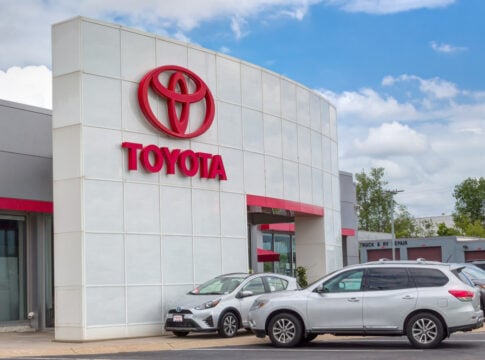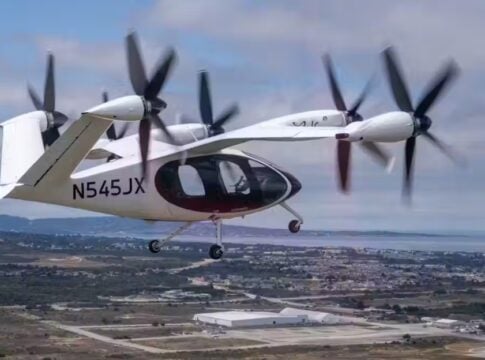After all these years and despite so many accomplishments, measures that save energy remain U.S. climate policy’s bastard child.
Even defenders of energy efficiency sell it short. The latest instance was last Friday’s NY Times column, Give Me Laundry Liberty or Give Me Death!, by the paper’s resident polemicist, the economist Paul Krugman.

Electricity Savings’ top role in reducing electric-sector emissions is especially critical because no other sector (transport, industry, etc.) cut emissions more than marginally.
Krugman rightly savaged Congressional Republicans for contesting U.S. Energy Department efficiency standards for washing machines and other major energy-consuming appliances. His column reminds us that today’s G.O.P. never passes up an opportunity to force fossil fuels on the American public.
As Krugman noted, Republicans’ depiction of Democrats as enemies of freedom is exactly backwards: “Regulations ensuring that the appliances on offer are reasonably efficient reduce people’s cognitive burden — you might even say they increase our freedom,” by unshackling consumers from the task of weeding out inefficient (and expensive-to-run) appliances from efficient ones.
But consider what Nobel economics laureate Krugman left out: The only U.S. sector that has cut carbon emissions by more than token amounts since 2005 is electricity, furnishing a whopping 92 percent of the overall drop in emissions in 2023 since 2005. (See bar graph further below.) And energy savings, measured as kilowatt-hours that didn’t need to be generated because electricity savings curbed demand, accounted for 40 percent of electricity-sector carbon reductions — besting the 36 percent from power generators’ shift from coal to less-carbon-intensive fossil gas, and far surpassing the combined 24% share from growth in wind and solar electricity. (See pie-chart above. Details follow at end of post.)
Why are electricity savings undervalued?
Since 2005, the U.S. economy has grown by 40 percent in real (inflation-adjusted) terms. Yet over the same 18 years, U.S. electricity generation barely budged, rising just 5 percent. That is an immense change from mid-(20th)-century, when electricity usage typically grew each year by 6 or 7 percent, practically doubling every decade. This wrenching apart of electricity growth from economic growth has enabled the increased penetration of fossil gas-fired electricity and the rapid increase in wind and solar electricity to bite deeply into coal-fired power generation rather than simply add to it.
Yet energy savings are downgraded in energy and climate discourse. It’s not hard to see why.
First, energy saving is invisible. There are no ribbon-cuttings for energy-efficient buildings or appliances, no medals for low-energy lifestyles. Super-efficient houses or office buildings occasionally are singled out for praise, but what’s the visual — a low-electricity or gas bill? Or, worse, Jimmy Carter’s White House cardigan, which 1970s media held up for ridicule?
Second, saving energy lacks powerful lobbies. There’s no energy-saving counterpart to the American Gas Association, the American Wind Energy Association, the Solar Energy Industry Association, the National Coal Association, and certainly not the American Petroleum Institute, which was represented at the Mar-a-Lago dinner last week at which ex-president Trump pressed the fossil fuel industry for a billion dollars in campaign contributions. Only the American Council for an Energy-Efficient Economy and the Natural Resources Defense Council persistently advocate for energy effiicency, and they do so as tech experts and champions of the greater good rather than as arm-twisting lobbyists, and certainly not as bundlers of campaign cash.

Lime-green bars show CO2 emissions from electricity generation. The sole other sector with substantially lower 2023 emissions, “Other” Petroleum, shown in yellow, shrank due to natural gas’s increasing industrial-market share.
Energy efficiency and savings also suffer from a measurement problem. Implicit in measuring their climate contribution is a counterfactual: what would energy requirements and emissions have been without the energy savings?
For this post as well as predecessor posts in 2016 and 2020 I used as a baseline U.S. electricity generation if the 1975-2005 ratio between electricity growth and GDP growth had persisted. I think that was reasonable, but who’s to say? The avoided kWh’s I computed for the pie chart depend on a measuring convention that is subject to argument.
(Note that “offshoring” — the compositional shift of the U.S. economy toward services and away from manufacturing, with imports from China and other Asian countries furnishing the lost production — has also contributed to reducing the link between electricity and domestic economic activity; however, its numerical impact only accounts for a fraction of the flattening of U.S. electricity consumption over the paste two decades.)
Energy Efficiency’s Respect Deficit Is Consequential
Undervaluing energy efficiency means that energy-saving policy measures get short-changed. Efficiency standards for appliances, vehicles and buildings are insufficiently supported, enacted and enforced, leaving them vulnerable to being watered down or blocked altogether.
That’s the obvious part. More consequential is the cultural and political fallout. The short shrift accorded energy savings contributes to downplaying the demand side of energy and climate. This in turn has contributed to the unfortunate narrowcasting of climate campaigns to campaigns to block supply expansions. Measures that would curb consumption get disregarded, even though they are arguably more enduring and effective in curbing climate-damaging emissions than campaigns to halt drilling or pipelines, which largely relocate supply expansions elsewhere.
A major casualty of this narrowcasting is sidelining of carbon pricing as a serious policy contender. That’s not to say that the U.S. would necessarily have robust carbon pricing if energy savings were given their due. Rather, the marginalizing of energy savings and of carbon pricing are mutually reinforcing.
Part of the power of carbon taxing is that it operates on both the demand and supply sides of the fossil-fuel and emissions equation. (Another part is that carbon pricing complements virtually every other emissions-reducing policy or program.) Downgrading the demand aspect of our energy and climate miasma does a disservice to carbon pricing — and our climate.
Calculation Details
Calculations for this post were made in CTC’s carbon-tax model spreadsheet (2.2 MB downloadable Excel file). See Clean Electricity tab and Graphs tab. Pie-chart shares are derived by comparing 2023 and 2005 generation for solar (including distributed solar), wind and fossil gas and applying industry-average CO2 emission factors for coal and gas. Electricity-savings slice was computed by subtracting actual 2023 U.S. electricity generation from hypothetical 2023 generation if the average 1975-2005 ratio between electricity growth and GDP growth had continued through 2023, and then ascribing a per-kWh CO2 emission factor calculated as the mean of gas and coal CO2/kWh.
In crediting electricity with 92% of all 2005-2023 U.S. CO2 reductions (from fossil-fuel burning), I divided electricity-sector reductions of 983 million metric tons (“tonnes”) of CO2 by the total reduction of 1,064 million tonnes. However, the denominator is deflated by including “negative reductions” from passenger vehicles (14 million tonnes) and gas for industry (206). Even removing those sectors from the denominator, electricity accounted for 77% of total gross reductions (983 divided by 1,284). Note that these figures are shown in the Outcomes tab of CTC’s carbon-tax model.
Carbon Footprint
Toyota’s (TM Stock) Q1 Twist: Why Profits Dip But Hybrids Surge, and Net Zero Goals Accelerate
Toyota Motor Corporation reported a sharp drop in earnings for the quarter ending June 30, 2025. Net profit fell 37% to ¥841 billion ($5.7 billion), down from ¥1.33 trillion a year earlier. This marked one of the steepest quarterly declines in recent years. Revenue, however, rose 3% year-over-year to ¥12 trillion ($82 billion), supported by strong demand in North America and Asia.
The primary drag came from new U.S. tariffs of 15% on Japanese car imports, which reduced profit by an estimated ¥450 billion. Higher costs for raw materials and a stronger yen hurt overseas earnings. Global inflation also impacted the results.
Toyota has revised its full-year operating profit forecast downward to ¥2.66 trillion ($18 billion). This speaks of a more cautious outlook for 2025. Analysts say the biggest automaker is keeping strong sales. However, profit margins face pressure from outside economic factors.
Amid the financial hiccup, the company reaffirmed its commitment to climate leadership. It aims for carbon neutrality with strong emissions targets, green manufacturing projects, and renewable energy investments. This effort is part of its Environmental Challenge 2050 framework.
Hybrids Take the Wheel as Sales Defy the Downturn
Global vehicle sales for the quarter reached 2.4 million units, up from 2.2 million a year ago. Toyota’s sales in North America rose nearly 20% in July. This boost came from its hybrid models, like the RAV4 Hybrid and Camry Hybrid, which both showed double-digit growth.

Hybrid and plug-in hybrid models make up over one-third of Toyota’s total sales. This shows how important electrified powertrains are becoming in the company’s lineup.
Battery electric vehicle (BEV) sales, while still a smaller portion, increased steadily in markets with expanding charging infrastructure.
Toyota stayed on top in Japan and Southeast Asia. This was thanks to its compact cars and commercial vehicles. However, European sales dipped a bit due to tougher emissions rules and strong competition from local EV brands.
Toyota’s share price fell about 1.6% following the earnings announcement, as tariff concerns weighed on investor sentiment. Even with this dip, the stock still looks good. Its forward price-to-earnings (P/E) ratio is 6.9. That’s lower than the industry average of 8.0 and Toyota’s five-year average of 9.3.
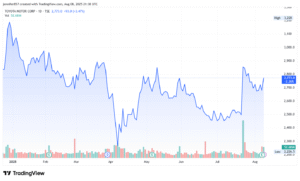
Driving Toward 2050: Toyota’s Net Zero Roadmap
Toyota has set a long-term target to achieve carbon neutrality across the entire life cycle of its vehicles by 2050. This goal covers emissions from all stages: vehicle design, production, use, and recycling. It also includes emissions from suppliers and logistics partners.
In its latest sustainability report, Toyota reported its Scope 1 and Scope 2 greenhouse gas emissions. These emissions, from direct operations and purchased electricity, reached around 2.05 million metric tons of CO₂e in FY 2024. This shows a 15% drop from FY 2019 levels. The company aims to cut these emissions by 68% by 2035, using 2019 as the baseline year.
For Scope 3 emissions, which account for most of Toyota’s footprint, targets are set. By 2030, Toyota aims for a 30% reduction from suppliers, logistics, and dealerships. They also seek a 35% cut in average vehicle-use emissions. These goals account for the fact that tailpipe emissions from vehicles remain the single largest part of the company’s climate impact.
Globally, Toyota is investing in solar, wind, hydrogen, and renewable natural gas to power its factories. It has also joined multiple international coalitions to accelerate low-carbon manufacturing and logistics.
The largest carmaker is investing a lot in renewable energy. They plan to use 45% renewable electricity in North America by 2026. By 2035, they aim for 100% renewable energy at all global plants.
Projects include:
- Large-scale solar panel installations at assembly plants
- Hydrogen-powered forklifts
- Renewable natural gas systems at engine facilities.
The company’s approach combines electrification with manufacturing decarbonization. This includes hybrids, battery electric vehicles (BEVs), and hydrogen fuel cell vehicles.
Toyota’s leaders think this multi-pathway strategy will reduce emissions quickly. This is especially true in areas where full BEV infrastructure is still growing. It also helps ensure steady progress toward the company’s 2050 carbon neutrality goal.

In summary, the company’s near-term reduction targets are:
- 68% reduction in Scope 1 and 2 emissions by 2035 (compared to 2019 levels).
- 30% cut in Scope 3 emissions from suppliers, logistics, and dealerships by 2030.
- Matching 45% of electricity use with renewables in North America by 2026.
Environmental Challenge 2050: Six Pillars of Action
Toyota’s Environmental Challenge 2050, launched in 2015, remains its guiding framework for sustainability. The initiative is built on six core challenges:
- Zero CO₂ emissions from new vehicles through hybrid, BEV, and hydrogen fuel cell adoption.
- Zero CO₂ emissions in manufacturing by shifting to renewable energy and low-carbon processes.
- Life cycle zero CO₂ emissions, including recycling and parts reuse.
- Minimizing water usage and improving water discharge quality.
- Protecting biodiversity around manufacturing sites and supply chains.
- Advancing a circular economy by extending product lifecycles and reducing waste.
Toyota aims to sell 1.5 million BEVs annually by 2026 and 3.5 million by 2030, alongside continuing hybrid and fuel cell development. This multi-path approach allows the company to meet varying customer needs and infrastructure readiness levels worldwide.
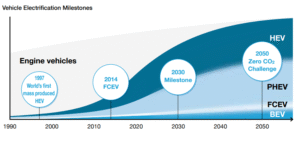
Green Manufacturing: Major Investments in Low-Carbon Plants and ESG
Toyota’s largest new sustainability investment is a ¥140 billion ($922 million) advanced paint facility in Georgetown, Kentucky. Set to open in 2027, the plant will reduce paint shop carbon emissions by 30% and cut water use by 1.5 million gallons annually.
In Japan, Toyota is piloting hydrogen-powered forklifts and solar-powered assembly lines. The company will use 100% renewable electricity for its manufacturing in Europe by 2030.
These projects reduce environmental impact and boost operational efficiency. They support Toyota’s goals of sustainability and profitability.
Beyond emissions, Toyota is strengthening its broader ESG performance. The company has strict human rights rules for suppliers. These rules include labor conditions, conflict minerals, and environmental compliance. By 2030, Toyota aims for 90% of its top suppliers to set their own science-based emissions targets.
In 2024, Toyota diverted 94% of waste from landfills globally and recycled over 99% of scrap metal from manufacturing. It also invested in reforestation projects in Asia and Africa as part of its carbon offset strategy.
Balancing Short-Term Pressures With Long-Term Goals
The April–June quarter highlighted Toyota’s resilience in the face of macroeconomic challenges. Tariffs and currency changes have hurt short-term profits. However, strong vehicle sales, especially in hybrids, keep the company competitive.
At the same time, Toyota is moving ahead with one of the most thorough sustainability programs in the auto industry. Its carbon neutrality goals and the Environmental Challenge 2050 framework guide its actions. Also, large-scale green manufacturing investments help meet the growing demands for cleaner mobility from regulators and consumers.
As Toyota navigates market volatility, its ability to deliver both financial and environmental strategies will be key to maintaining global leadership in the shift toward sustainable transportation.
The post Toyota’s (TM Stock) Q1 Twist: Why Profits Dip But Hybrids Surge, and Net Zero Goals Accelerate appeared first on Carbon Credits.
Carbon Footprint
JOBY Aviation Stock Soars on Blade Acquisition and Electric Air Taxi Commercial Launch Plans
Joby Aviation Inc. (NYSE: JOBY) is closing in on its dream of launching electric air taxis. The California-based company has spent years building its all-electric, vertical take-off and landing (eVTOL) aircraft, designed for fast, quiet, and convenient city travel.
This August, Joby made a series of bold moves that pushed it closer to commercial operations, from a high-profile acquisition and defense partnership to major FAA progress and manufacturing growth. Investors noticed, sending the stock near record highs.
Blade Deal Unlocks Instant Market Access and Growth
One of the month’s biggest headlines came on August 4, when Joby announced plans to acquire Blade Air Mobility’s passenger business for up to $125 million in cash or stock.
The deal is a game-changer. Blade brings premium infrastructure, including dedicated terminals at major New York airports and a strong presence in Southern Europe. More importantly, it comes with a loyal customer base — more than 50,000 passengers flew Blade in 2024.
By absorbing Blade’s passenger operations, Joby gains instant market access without the time and expense of building from scratch. The acquisition is expected to slash infrastructure costs, speed up customer acquisition, and put Joby ahead of competitors in key urban corridors.
The transaction is set to close in the coming weeks, pending customary approvals. Once complete, Blade’s passenger services will continue under Joby’s ownership, setting the stage for a smooth integration.
- READ MORE: Boosting Aviation Carbon Credits: ICAO Greenlights Verra’s VCS Program for CORSIA Carbon Market
Defense Partnership Opens a New Revenue Stream
Joby revealed another major move, a collaboration with defense contractor L3Harris.
The partnership will develop a gas turbine hybrid variant of Joby’s existing eVTOL aircraft for low-altitude defense missions. The design aims to combine Joby’s manufacturing expertise with L3Harris’ deep defense technology capabilities.
Flight testing is set to begin this fall, with operational demonstrations planned during government exercises in 2026.
This venture signals Joby’s ambition to be more than just a commercial passenger service. By stepping into the defense sector, Joby diversifies its revenue streams and showcases its aircraft’s versatility for both civilian and military use.
FAA Certification Moves Into Final Stages
On August 6, Joby shared a crucial regulatory update. It has started final assembly of its first FAA-approved electric air taxi, a major step toward Type Inspection Authorization (TIA) flight testing. This stage needs FAA-approved test plans, a certified design, and proven manufacturing — all of which Joby has achieved, with over 50% of its test plans already accepted.
- Joby’s balance sheet is strong, ending Q2 2025 with $991 million in cash, cash equivalents, and marketable securities.
The company also closed the first $250 million tranche of a $500 million strategic investment from Toyota, one of Joby’s largest and most influential partners.
For 2025, Joby expects to use between $500 million and $540 million in cash, excluding the Blade acquisition. Revenue remains small, just $59,600 expected for Q2, but growth projections are huge, with a forecasted 900% year-on-year increase from a low base.
JoeBen Bevirt, founder and CEO of Joby, said,
“This is a pivotal moment. Regulatory progress around the world is unlocking market access, our commercialization strategy is taking hold, and we’re now focused on scaling production to meet real demand—a challenge we’re fully committed to and working hard to deliver on.”
JOBY Stock Surge Reflects Growing Investor Confidence
Joby’s recent string of announcements sent its stock soaring. In the past month alone, shares have jumped more than 70% due to heavy trading. Year-to-date, the stock has risen 142%, surpassing its market capitalization of $14 billion.
However, volatility remains. Analyst price target changes and insider sales have caused swings, but the long-term outlook hinges more on regulatory milestones than short-term earnings.
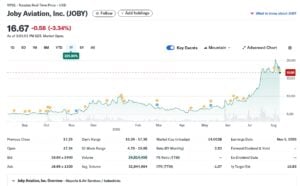
Manufacturing Expansion Doubles Output
To meet growing demand, Joby expanded its Marina, California, manufacturing facility to 435,000 square feet. This upgrade will double production capacity to 24 aircraft per year.
Meanwhile, its newly renovated Dayton, Ohio, site is ramping up to produce and test key aircraft components. Over time, Dayton could scale to build up to 500 aircraft annually, making it a cornerstone of Joby’s manufacturing strategy.
International Partnerships Boost Global Reach
Joby is not just looking at U.S. cities. The company also announced an expanded partnership with ANA Holdings in Japan.
The two companies plan to deploy over 100 Joby air taxis starting in Tokyo, creating an urban air mobility ecosystem complete with dedicated vertiports and operational support. The partnership will leverage Toyota’s network and government cooperation to fast-track development.
Joby also signed new agreements with Abdul Latif Jameel and ANA to explore deploying approximately 300 aircraft in other markets.
What’s Next for Joby Aviation?
With the Blade acquisition, defense partnership, FAA certification progress, and global expansion, Joby is executing on multiple fronts at once.
The next 12 months will be critical. If Joby completes certification on schedule, ramps production, and integrates Blade’s passenger network, it could be one of the first eVTOL companies to operate at scale.
For now, investors are betting big that Joby’s head start, strategic partnerships, and strong balance sheet will translate into a dominant position in the fast-emerging air taxi market.
Joby Aviation isn’t just inching toward launch; it’s accelerating. From New York to Dubai to Tokyo, the pieces are falling into place for a global eVTOL network. If all goes according to plan, 2026 could be the year flying taxis move from concept to reality.
The post JOBY Aviation Stock Soars on Blade Acquisition and Electric Air Taxi Commercial Launch Plans appeared first on Carbon Credits.
Carbon Footprint
Carbon footprint offsetting strategies: How leading companies neutralise their emissions
Reaching net zero isn’t just a visionary pledge anymore; it’s a business imperative. From investor expectations and ESG benchmarks to customer scrutiny and upcoming regulation, the pressure on companies to decarbonise is accelerating. But while reducing internal emissions is essential, there’s growing recognition that carbon offsetting strategies are a vital part of the solution, not a shortcut.
![]()
-
Climate Change2 years ago
Spanish-language misinformation on renewable energy spreads online, report shows
-
Climate Change Videos2 years ago
The toxic gas flares fuelling Nigeria’s climate change – BBC News
-

 Greenhouse Gases1 year ago
Greenhouse Gases1 year ago嘉宾来稿:满足中国增长的用电需求 光伏加储能“比新建煤电更实惠”
-

 Climate Change1 year ago
Climate Change1 year ago嘉宾来稿:满足中国增长的用电需求 光伏加储能“比新建煤电更实惠”
-

 Carbon Footprint1 year ago
Carbon Footprint1 year agoUS SEC’s Climate Disclosure Rules Spur Renewed Interest in Carbon Credits
-
Climate Change2 years ago
Why airlines are perfect targets for anti-greenwashing legal action
-
Climate Change Videos2 years ago
The toxic gas flares fuelling Nigeria’s climate change – BBC News
-
Climate Change2 years ago
Some firms unaware of England’s new single-use plastic ban



